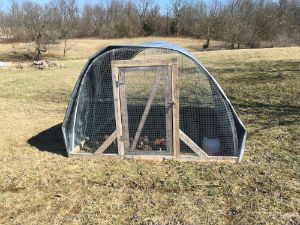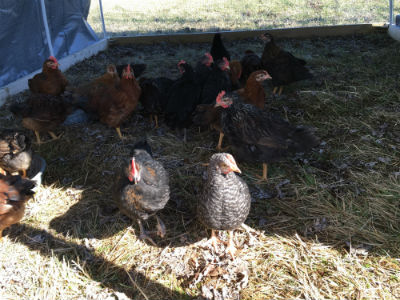 The teens have been going out in the tractor daily. We’re glad they’re out, they’re glad to be out, and the rabbit does are undoubtedly glad their noisy neighbors are out during the day.
The teens have been going out in the tractor daily. We’re glad they’re out, they’re glad to be out, and the rabbit does are undoubtedly glad their noisy neighbors are out during the day.
The grass is already greening up, and both the adult and juvenile chickens are enjoying the tender shoots. We ensure that the teens have chick grit in the tractor so they can “chew” up the grass (and any other edibles, like bugs) in their gizzards. While flies appeared recently, the true bug smorgasbord won’t occur for a couple of months; when it does, though, the chickens and ducks will get their fill of creeping, hopping, and flying bugs every day. And they’ll turn that good protein into delicious eggs.
Back to the teens: they seem to know the drill now – while they don’t exactly voluntarily jump into the transport bin in the morning or evening, they settle down quickly once they’re caught. Well, except for the marans crosses, who are noisy and seem to be troublemakers. They constantly square off with the other teens. This isn’t really surprising, though, since their mother was bossy, noisy, and high-ranking in the flock pecking order. They are her progeny, after all.

We’re looking forward to seeing the teens’ adult coloration, since there could be some very interesting patterns within the gene pool. So far, the marans crosses look pretty much like cuckoo marans – barred – but the Rhode Island Red or New Hampshire crosses have more “wild” coloring than their mothers do (clearly, the rooster’s contribution). The Australorp crosses mostly look like Australorps at this point – solid black – but one cockerel has some brownish hackle feathers. One of the most unusual chicks is one that looks like a Silver-Laced Wyandotte cross – it has both silver feathers and brown feathers. The Gold-Laced Wyandotte crosses are very pretty and look gold-laced, but don’t have the rose combs, so their father’s single comb must be the dominant gene.
The teens keep growing (and some are crowing), and will go live in the adult coop before too long. In a few more months, the pullets will lay their first eggs and that will be a momentous day – Generation 2 eggs!
